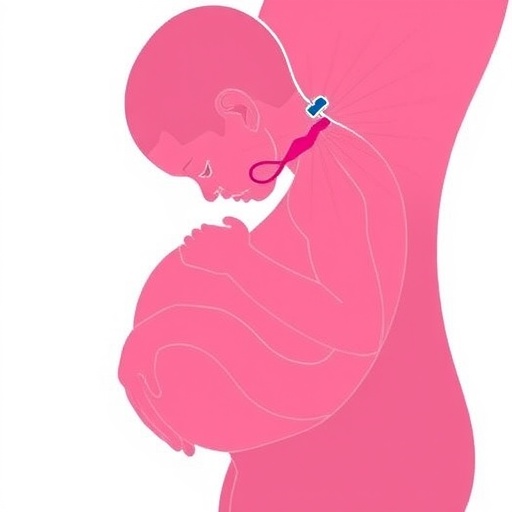In a landmark advance poised to transform prenatal care, recent research has unveiled compelling evidence that the prenatal repair of myelomeningocele—a severe form of spina bifida—significantly diminishes the necessity for long-term feeding support in affected infants. This groundbreaking finding not only underscores the profound impact of early surgical intervention on neural integrity but also opens new avenues for optimizing developmental outcomes in this vulnerable population. The study meticulously analyzed the long-term feeding abilities of children who underwent fetal surgery compared with those managed postnatally, revealing an encouraging reduction in feeding complications and dependence on medical support following prenatal repair.
Myelomeningocele, the most severe manifestation of spina bifida, occurs when the spinal canal fails to close completely during early fetal development, exposing neural tissue and leading to substantial neurological deficits. Historically, treatment was confined to postnatal surgical repair, often after irreversible damage had occurred, contributing to lifelong disabilities. However, the advent of fetal surgery heralded a paradigm shift, with early intervention demonstrating promise in preserving neurologic function by protecting exposed neural elements before birth. This recent investigation lends robust quantitative backing to this therapeutic approach, particularly with respect to oromotor and feeding capacities essential for survival and quality of life.
The complex physiology underpinning feeding difficulties in myelomeningocele stems from disruptions to neural circuits governing swallowing, suckling, and airway protection. The exposed spinal cord and affected brain structures frequently impair cranial nerves and the brainstem pathways, culminating in dysphagia, aspiration risks, and failure to thrive. Consequently, many infants with myelomeningocele rely on gastrostomy tubes or prolonged nasogastric feeding to maintain adequate nutrition. The innovative prenatal repair aims to mitigate these outcomes by reversing or minimizing neural damage through early surgical coverage of the spinal defect during gestation, ideally facilitating more normal neurological development and function.
.adsslot_wqV4So3bQ2{width:728px !important;height:90px !important;}
@media(max-width:1199px){ .adsslot_wqV4So3bQ2{width:468px !important;height:60px !important;}
}
@media(max-width:767px){ .adsslot_wqV4So3bQ2{width:320px !important;height:50px !important;}
}
ADVERTISEMENT
This study’s rigorous methodology involved a longitudinal cohort of infants diagnosed with myelomeningocele who received prenatal repair compared against a control group undergoing traditional postnatal correction. Researchers used validated feeding assessments and objective markers of feeding efficiency, including the requirement for supplemental feeding devices and incidence of aspiration-related complications, tracked across multiple developmental milestones. The comprehensive data set convincingly demonstrated that infants with prenatal intervention exhibited a statistically significant reduction in long-term feeding support needs, with many achieving full oral feeding capabilities earlier than historically observed.
Beyond the evident clinical benefits, these findings carry profound implications for healthcare resource utilization and family quality of life. Feeding dependencies necessitate extensive medical equipment, frequent hospital visits, and specialized caregiver training, all of which impose emotional and financial burdens on families and healthcare systems. A decrease in feeding support translates into reduced hospitalization duration, lowered risk of feeding-associated infections, and enhanced growth trajectories, ultimately fostering greater independence and neurodevelopmental progress in children affected by myelomeningocele.
The surgical technique employed in prenatal repair has evolved significantly over the past decade, balancing maternal safety with fetal benefits. Typically performed between 19 and 26 weeks of gestation, this delicate procedure involves carefully exposing the uterus, repairing the spinal defect under direct visualization, and meticulously closing the myofascial layers. The fetal environment’s relative plasticity during this period offers an unprecedented therapeutic window to preserve neural tissue integrity and stem the progression of neurologic dysfunction. This study’s confirmation of feeding outcome improvements adds a vital dimension to the spectrum of advantages attributed to fetal surgery.
Critically, the study also accounted for potential confounding variables such as lesion level, hydrocephalus severity, and coexisting anomalies, reinforcing the generalizability of its conclusions. Notably, the reduction in feeding support need was most pronounced in infants with lower lumbar lesions, suggesting that prenatal repair markedly benefits those at higher risk of motor and sensory deficits. Thus, prenatal surgical intervention not only offers neuroprotective effects but may also tailor outcome prognostication according to lesion characteristics, guiding decision-making processes for clinicians and expectant parents alike.
This evidence dovetails with growing insights into the pathophysiology of myelomeningocele, where secondary in utero trauma exacerbates neurological damage post neural tube closure. Chronic exposure of the spinal cord to amniotic fluid and mechanical trauma initiates a cascade of inflammation and scarring that compromises neural function. By sealing the defect early, prenatal repair halts this pathological sequence, preserving the neuronal circuitry critical for motor coordination and autonomic functions, including swallowing. Such mechanistic understanding bolsters the rationale for timely fetal interventions as a means of altering the natural disease trajectory profoundly.
While the current findings underscore the transformative potential of prenatal repair, it is essential to contextualize them within a framework of multidisciplinary care. Successful feeding outcomes depend not solely on surgical timing but also on comprehensive neonatal management, including skilled feeding therapy, vigilant respiratory support, and nutritional monitoring. The synergistic interplay of prenatal intervention with postnatal rehabilitative strategies amplifies the likelihood of achieving optimal neurodevelopmental milestones and functional independence, highlighting the need for integrated care pathways.
Further research remains imperative to delineate the long-term neurocognitive and psychosocial impacts of prenatal repair on children with myelomeningocele. Although improved feeding outcomes represent a critical milestone, the broader spectrum of motor function, bladder and bowel control, and cognitive development also warrants thorough investigation. Longitudinal follow-up studies will be vital in fine-tuning surgical indications, refining techniques, and tailoring supportive therapies to maximize lifelong benefits.
In addition to clinical considerations, ethical discourse has evolved in parallel with surgical capabilities. The invasive nature of fetal surgery, potential maternal risks, and prognostic uncertainties necessitate informed, compassionate counseling for families. By illustrating tangible improvements in foundational functions such as feeding, this study enhances the dialogue surrounding risk-benefit analyses and parental decision-making. Empowering families with clear evidence of efficacy could drive broader acceptance and uptake of prenatal repair in suitable candidates.
The implications of these findings extend into health policy arenas, where allocation of resources toward specialized fetal surgery centers must be justified by demonstrable clinical gains. Reduction in long-term feeding support represents a measurable metric that could inform cost-effectiveness analyses and reimbursement strategies. Furthermore, dissemination of best practice protocols and standardized outcome measures will be crucial to embedding prenatal repair as a standard of care worldwide.
Technological advances, including improvements in fetal imaging and minimally invasive surgical platforms, promise to refine prenatal repair further. Enhanced visualization and access may reduce procedure-related complications and expand eligibility criteria. As these innovations converge with the evidence base confirming functional benefits, a future where fetuses diagnosed with myelomeningocele routinely receive corrective interventions in utero seems increasingly realizable.
In conclusion, the study’s revelation that prenatal repair of myelomeningocele correlates with a marked reduction in the need for prolonged feeding support reshapes our understanding of fetal intervention’s impact. By safeguarding neural structures critical for swallowing and feeding, fetal surgery not only mitigates immediate health risks but also lays the foundation for improved developmental trajectories. This advancement heralds a new era in perinatal medicine, offering hope to families affected by this challenging congenital condition through the promise of enhanced quality of life and reduced morbidity.
Subject of Research: Prenatal surgical repair of myelomeningocele and its impact on long-term feeding support in affected infants.
Article Title: Prenatal repair of myelomeningocele is associated with lower need for long-term feeding support.
Article References:
Healy, J., Liu, C., Ehrlich, S. et al. Prenatal repair of myelomeningocele is associated with lower need for long-term feeding support. J Perinatol (2025). https://doi.org/10.1038/s41372-025-02356-4
Keywords: myelomeningocele, spina bifida, fetal surgery, prenatal repair, feeding support, dysphagia, neonatal care, neurodevelopment, gastrostomy, prenatal intervention
Tags: developmental outcomes in spina bifidaearly surgical intervention impactfeeding complications reductionfetal surgery benefitslong-term feeding support in infantsmyelomeningocele and feeding needsneonatal feeding abilities after surgeryneurological outcomes after prenatal repairoromotor function in childrenprenatal care innovationsprenatal myelomeningocele repairspina bifida treatment advancements





